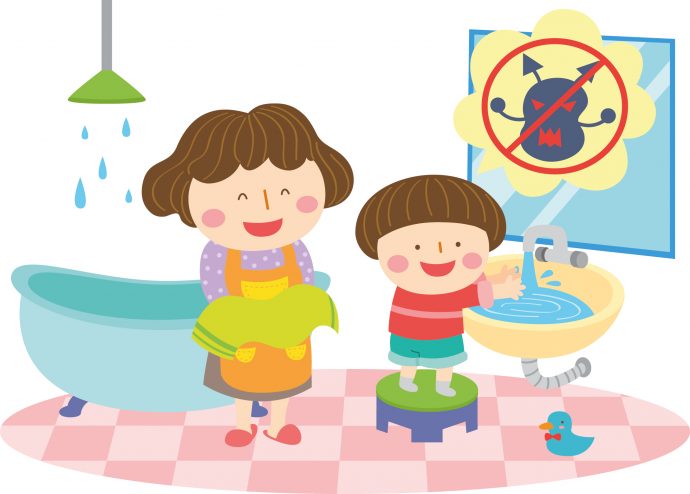Parents often teach their children that practising good household and personal hygiene can help prevent the spread of diseases. But do we truly understand how it helps to prevent the transmission of diseases? What about its limitations?
What is hygiene?
Hygiene refers to practising habits that promote cleanliness and can help prevent the spread of disease. There are two main types: household and personal.1
Household hygiene
This refers to household or daily habits that ensure the cleanliness of the house and its surrounding environment. This includes things like general cleaning, sanitisation, proper removal of waste, and disinfection of household areas (e.g. the kitchen counter, bedroom, toilet, shower).1
Personal hygiene
This refers to practising habits that ensure the cleanliness of an individual’s body, which also helps to prevent diseases or spread of infections to others. This includes habits like handwashing, showering, brushing teeth, etc.2
Hygiene is important to prevent disease transmission
Poor personal and household hygiene not only increase your child’s risk of infections, it can also endanger those around them. Studies have shown that poor hygiene is associated with the transmission of many diseases.3,4,5
For example:
- Not washing hands after playing outside and handling food can transmit bacteria such as coli, Salmonella, etc.5,6
- Not brushing their teeth regularly can lead to dental-related infections (e.g. tooth decay and gum disease).5,7,8
- Improper cleaning of the interior of the house can lead to the growth of mould on various household surfaces, which can lead to irritation of the airways and various symptoms (e.g. wheezing, coughing, irritated/red skin or eyes).9,10
- Improper removal of waste from the house may generate a breeding ground for many biological vectors such as flies and rodents, which can increase the risk of contracting various illnesses (e.g. food poisoning, diarrhoea, worm infections).11
Practising good personal and household hygiene can help break the cycle of contagious virus for many diseases. Therefore, the risk of contracting diseases or transmitting it to others is reduced.4
Is hygiene alone enough to protect children?
In some cases, hygiene alone is not enough to prevent infections. Therefore, it is important to incorporate other preventive measures into our children’s lives. The COVID-19 pandemic has already introduced us to many of these physical measures of preventing infections such as physical distancing and practising respiratory etiquette (covering your mouth/nose when coughing or sneezing).12,13
It is equally important to take care of our immune system in order to ensure optimal immunity and to keep diseases at bay. This can be achieved through eating a healthy and balanced diet, getting enough sleep each night, and regularly exercising.14
In addition to this, vaccination is another key preventive measure parents should consider. Vaccination can help prevent many infectious diseases or reduce the burden of infectious diseases in children. This is especially true in the case of rotavirus, which is a highly contagious virus that can be hard to control despite good hygiene.15
Rotavirus: common and contagious
Rotavirus is a common cause of severe diarrhoea in young children. Symptoms include diarrhoea that lasts for several days, vomiting, fever, and tiredness. It is primarily transmitted by the faecal-oral route. Rotavirus is highly contagious and can stay alive on surfaces and objects for weeks.16 Rotavirus vaccines are recommended for babies from age 6 weeks. They are available in either 2 or 3 doses depending on the type. Consult with a paediatrician to learn more about rotavirus vaccination.17,18
Practising proper household and personal hygiene is one of the easiest ways to stave off diseases. However, hygiene alone has its limitations in preventing diseases. Therefore, it is important that parents also ensure their child’s health through maintaining a healthy immune system and considering vaccinations.
References
- International Scientific Forum on Home Hygiene. (2022). What is home and everyday life hygiene? IFH. Retrieved from https://www.ifh-homehygiene.org/what-home-hygiene
- Ames, H. (2020). Why is personal hygiene important? Retrieved from https://www.medicalnewstoday.com/articles/personal-hygiene
- World Health Organization: WHO. (2022). Sanitation. Retrieved from https://www.who.int/news-room/fact-sheets/detail/sanitation
- Aiello, A. E., & Larson, E. (2002). What is the evidence for a causal link between hygiene and infections? Lancet Infectious Diseases, 2(2), 103–110. https://doi.org/10.1016/s1473-3099(02)00184-6
- Santos-Longhurst, A. (2021). What Does It Mean to Have Bad Hygiene? Healthline. Retrieved from https://www.healthline.com/health/healthy-lifestyle/bad-hygiene#why-hygiene-matters
- World Health Organization. (2022). Food safety. Retrieved from https://www.who.int/news-room/fact-sheets/detail/food-safety
- Mayo Clinic. (2021). Oral health: A window to your overall health. Retrieved from https://www.mayoclinic.org/healthy-lifestyle/adult-health/in-depth/dental/art-20047475
- Centers for Disease Control and Prevention. (2022). Hygiene-related Diseases. Retrieved from https://www.cdc.gov/hygiene/disease/index.html
- Centers for Disease Control and Prevention. (2022). Basic Facts about Mold and Dampness. Retrieved from https://www.cdc.gov/mold/faqs.htm
- Mayo Clinic. (2021). Mold allergy – Symptoms and causes. Retrieved from https://www.mayoclinic.org/diseases-conditions/mold-allergy/symptoms-causes/syc-20351519
- Yue, F., et al. (2022). Household solid waste management practices and perceptions among residents in the East Coast of Malaysia. BMC Public Health, 22(1). https://doi.org/10.1186/s12889-021-12274-7
- Centers for Disease Control and Prevention. (2023). How to Protect Yourself & Others. Retrieved from https://www.cdc.gov/coronavirus/2019-ncov/prevent-getting-sick/prevention.html
- Harvard Health. (2021). How to prevent infections. Retrieved from https://www.health.harvard.edu/staying-healthy/how-to-prevent-infections
- Harvard Health. (2021). How to boost your immune system. https://www.health.harvard.edu/staying-healthy/how-to-boost-your-immune-system
- Dennehy, P. H. (2008). Rotavirus Vaccines: an Overview. Clinical Microbiology Reviews, 21(1), 198–208. https://doi.org/10.1128/cmr.00029-07
- Richards, L. (2023). What to know about rotavirus transmission. Retrieved from https://www.medicalnewstoday.com/articles/rotavirus-transmission#rotavirus-transmissi
- Centers for Disease Control and Prevention. (2018). Rotavirus Vaccination. Retrieved from https://www.cdc.gov/vaccines/vpd/rotavirus/index.html
- MIMS Malaysia. (n.d.). Vaccine, rotavirus: Indication, Dosage, Side Effect, Precaution | MIMS Malaysia. Retrieved from https://www.mims.com/malaysia/drug/info/vaccine,%20rotavirus?mtype=generic






Comments